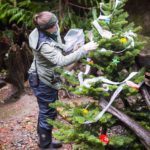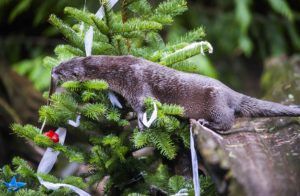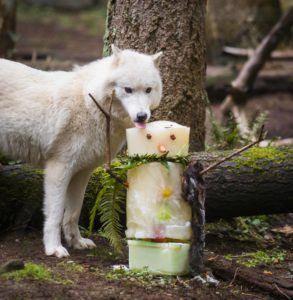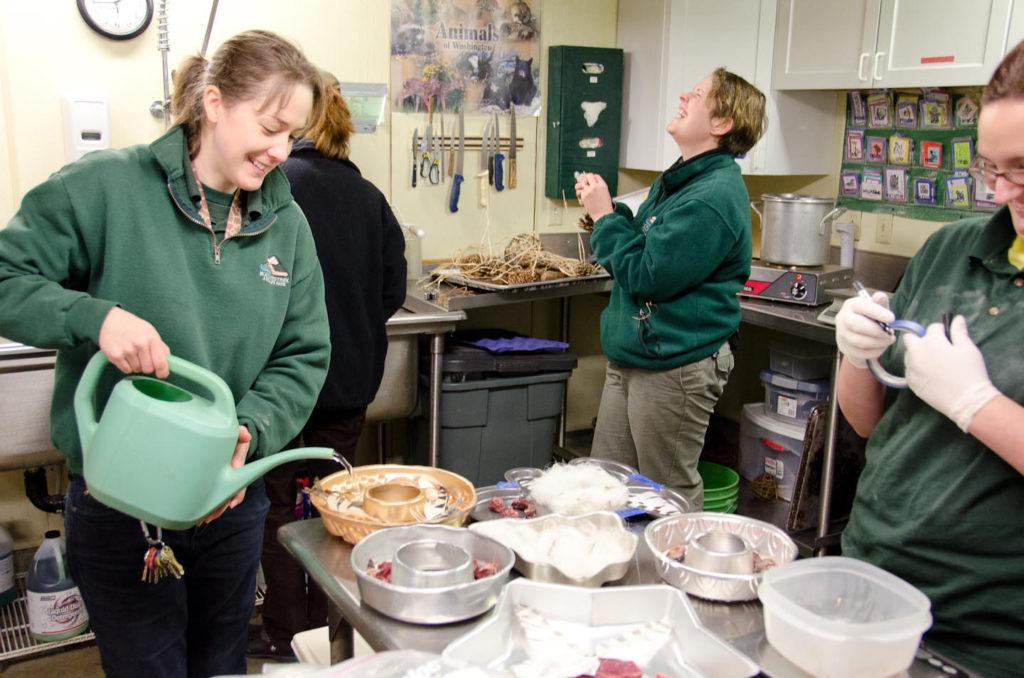It’s a cold morning at Northwest Trek – a hushed, frozen stillness rising off the lake. But it’s not bothering Fern at all. The black bear has her head down, wrenching a branch off a fir tree to pad out her winter den. As she does, keeper Angela Gibson looks on in satisfaction: this is no ordinary holiday tree. It’s a piece of enrichment, carefully designed to improve Fern’s life – and it’s definitely working.

“Enrichment is about providing the animals with experiences where they can express their natural behaviors and desires,” explains Gibson. “It creates opportunities for the animals to make choices in their day based on what they want to do.”
The lead carnivore keeper for Northwest Trek is a veteran at creating enrichments – like holiday trees at the upcoming Winter Wildland event – and she’s always exploring new ideas.
But then, so are all the rest of the keepers.
Getting creative
“That’s one of mine,” says Deanna Edwards, Free-Roaming Area keeper, pointing to a cardboard gingerbread house just about the right size for a skunk. Painted with candy-colored (and non-toxic) swirls, it’s stacked alongside cardboard trees, stars, gingerbread men and paper chains in the keeper offices. There’s even a cardboard sleigh pulled by cardboard reindeer. All are made by the wildlife park staff to be given to animals as Winter Wildland enrichment – holiday-themed, of course, and filled with meatballs, veggies, chopped fruit or other yummy items to entice skunks, lynxes, beavers and others to explore and investigate.

The animals love it. But for the humans involved, the pile in the office represents months of creative work to design an enrichment that will stimulate an animal while keeping it safe and healthy.
“I really wanted to make a house, but of course we can’t use glue or duct tape, or they’d eat it,” explains Edwards, who began making her items in November. “So I figured out this method of slots and tabs to attach the roof. I’m kind of proud of that. But we all make things: keepers, the volunteers, the interns and the education staff. It’s a big group effort.”
Crafty ingenuity and time is one part of making enrichments for animals – especially those with super-sharp teeth, long claws and prodigious strength.
Science-based enrichment

But the other big part is science.
“The goal is to encourage an animal’s natural behaviors,” says zoological curator Marc Heinzman. “That’s what they’re wired to do, and that’s what will give them the best mental and physical health.”
So Heinzman and his team start with what they know about a species, and ask the question: ‘What behavior do we want to encourage?’ For a bear, that might be digging or swimming. For a lynx or cougar, it might be stalking or climbing trees. For a skunk, it might be foraging.
Then they look at how to recreate that behavior using materials safe for the animal.
“For example, wolves are social animals, so we want to encourage pack behavior,” Heinzman says. “So we would give them a bigger piece of meat all at once to help them go through pack dynamics, learn how to eat as a group. For a bear we might hide food in a log so it had to dig.”
But enrichments aren’t all about food – delicious though that is for all of us. Last winter, Trek horticulturalist Jake Pool worked with Gibson to lay down cut trees for the wolves to use as running and scouting routes. And any item – even just a cardboard box – can be exciting for animals if it smells of something or someone new to them.
“I get a lot of ideas from Pinterest,” Edwards smiles. “You get creative.”
Good for humans, too

As it gets closer to Winter Wildland, all hands are on deck. Staff visit a local tree farm to pick up a donation of holiday trees. Volunteers get busy making stars out of pineapples and popsicles out of watermelon. And as she makes her rounds in the Free-Roaming Area, Edwards collects stray mountain goat fur and fallen goose feathers to use as enticing tree ornaments for the wolves.
Making animal enrichments, it seems, is enriching for humans too.
“I love doing this,” Edwards says. “Anything that makes an animal’s life better.”
-Rosemary Ponnekanti, Northwest Trek